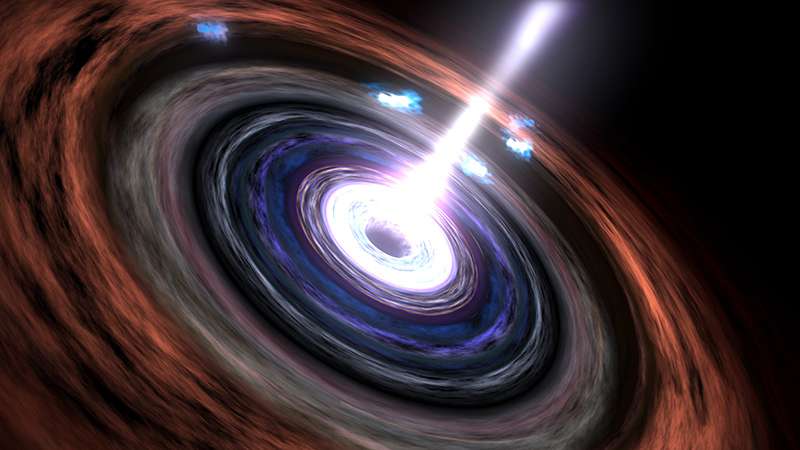Astronomers reveal how black holes power the brightest objects in the cosmos

What is the brightest object in the night sky?
Paradoxically, the most luminous things in the cosmos are actually invisible to the naked eye. They are "blazars," mysterious objects that glow not just with visible light—the kind our eyes can see—but with every kind of radiation, from radio waves to gamma rays. At the Boston University Blazar Lab, astronomers Alan Marscher and Svetlana Jorstad and their students are trying to understand how blazars work and where they get their tremendous energy. They think that blazars are powered by supermassive black holes containing the mass of hundreds of millions of suns. But how do black holes—where gravity is so strong that nothing, not even light, can escape—power the brightest objects in the cosmos?
That is the puzzle that Marscher, a professor of astronomy in BU's Institute for Astrophysical Research (IAR), and Jorstad, an IAR senior research scientist, are trying to resolve. Add up all the light that comes from blazars and they are the most luminous objects in the universe. But most of this light isn't in a form that we can see. It is spread out through the entire electromagnetic spectrum—the true rainbow that extends far beyond the colors that our eyes can detect and includes radio waves, X-rays, gamma rays, and more. Though some fluke astrophysical phenomena may shine brighter than a blazar for a few minutes or less, blazars keep up the light show for the long haul.

Today, astrophysicists have catalogued thousands of blazars. In fact, say Jorstad and Marscher, if we could see the cosmos with gamma-ray eyes, blazars would dominate the night sky. But what are they, and how do they sustain such powerful cosmic fireworks? When the first blazar was discovered in 1962, astronomers were stumped: they did not know what it was and had never seen anything like it. But time and technology, like NASA's Hubble Space Telescope, have yielded some clues.
First, astronomers tracked blazars to ancient galaxies located hundreds of millions, or even billions, of light years from Earth. Each of these galaxies, like our own Milky Way, is centered on a supermassive black hole that's engulfed millions of suns' worth of matter. Somehow, researchers think, those behemoth black holes must be firing up the blazars.
But even though nearly every galaxy has a supermassive black hole, only a small fraction of galaxies—about one in ten—is an "active" galaxy, radiating a huge amount of energy. And fewer than one in a thousand active galaxies is a blazar. What makes them different?
It all starts with the black hole's diet. Black holes gobble up anything that gets too close. When a black hole is "well fed," says Marscher, matter on its way down the gullet will congeal in a pancake-shaped disk centered on the black hole. Friction in the disk heats it up and makes it glow and flicker with ultraviolet and visible light. That explains one part of the mystery—why some galaxies are "active" when others aren't—but something more seems to happen to transform an ordinary active galaxy into a blazar capable of firing off high-energy gamma rays and X-rays.
Astronomers think that "something" is a jet: a fire hose of charged particles, magnetic fields, and radiation that shoots out from the top and bottom of the rotating disk. When one of these jets is pointed directly at Earth, our telescopes pick it up as a blazar. "The black hole sucks nearly everything in from its surroundings," says Marscher, "but it creates so much havoc as everything falls in that somehow jets get shot out." When fast-moving electrons near the black hole meet the strong magnetic field inside the jet, they give off a broad spectrum of radiation, from low-frequency radio waves all the way up to high-energy X-rays. Meanwhile, those electrons can also ram into particles of light, called photons, and give them the extra boost of energy to make gamma rays.
Which might leave you asking: What, exactly, kicks the electrons up to such high speeds? Astrophysicists are still debating, but many think that the electrons are whorled through a corkscrew-shaped magnetic field that shoots them out at blinding velocity. Marscher compares the effect to cleaning a pipe out with a snake. "If you keep twisting it around, then it will propel in the forward direction," says Marscher. "If the black hole's rotation can wind up the magnetic field enough, that's what propels the jets out at nearly the speed of light."
If that hypothesis is right, the twisty magnetic field should leave a characteristic imprint, called polarization, on light coming out of the jet. But isolating that signature is not easy. To do it, Marscher, Jorstad, and a team of international collaborators had to wait for a blazar to discharge a flare—temporary, concentrated emission—that would give them a chance to trace out the shape of the magnetic field. The team started searching for the polarization signal in 2004, and in 2005, they found just what they were seeking: while peering nearly straight down the barrel of the jet of a powerful, flaring blazar called BL Lacertae, they caught the polarization within the flare rotating by one-and-a-half turns, mapping out exactly the spiral shape astronomers had predicted. They presented their results in Nature in 2008.
Flares like this one represent "nature doing its most extreme thing," says Marscher, but flares are rare, and catching them in the act requires long-term, dedicated telescope time. Thanks to a partnership between BU and the Lowell Observatory, Marscher and Jorstad have near-continuous coverage of more than three dozen blazars on the Perkins telescope, a 1.8-meter optical telescope near Flagstaff, Arizona, where Jorstad spends about one week each month. When a flare erupts, she quickly notifies the managers of NASA's Swift satellite, which can be rapidly pointed toward the flare source to capture ultraviolet and X-ray readings, and taps into publicly available data from the Fermi Gamma-ray Space Telescope. By scrutinizing differences in the shape and timing of the flare at different wavelengths, she, Marscher, and their colleagues can deduce the physics behind the flare.
Marscher and Jorstad also enlist a network of radio telescopes, called the Very Long Baseline Array (VLBA), to zoom in on the flare and take pictures of it as it moves and changes. Because the telescopes that make up the VLBA are located on opposite sides of the Earth, the VLBA can pick out, or "resolve," fine details about 1,000 times better than the Hubble Space Telescope. In fact, even though the jets are enormous—many light years long, in some cases—they are so far from Earth that the VLBA is the only instrument in the world that can actually see bright spots (technical term: "blobs") moving through the jets.
Now, the researchers in BU's Blazar Lab are trying to understand the source of blazars' most energetic gamma ray flares, the blazar equivalent of a baseball pitcher's 100-mile-an-hour fastball. Astrophysicists expected that the gamma rays should all be coming from very close to the black hole at the center of the blazar. But, to everyone's surprise, the BU team found that a major fraction of the gamma rays is coming from a point, light years away. How does such an extreme burst of energy happen so far from the blazar's central engine? The BU blazar team is testing out a variety of ideas using computer models, and they hope to put them to a real-world test soon with the Discovery Channel Telescope, a 4.3-meter optical telescope at Lowell Observatory.
Yet the "eureka" moments often belong to the undergraduate and graduate students in blazar lab, who are the first link in the lab's data analysis chain. "They are often the first to tell us when an event—a flare in brightness, change in polarization, or a new 'blob'—appears in the data," says Marscher. "They are in fact directly participating in the exploration of cosmic phenomena."
More information: Alan P. Marscher et al. The inner jet of an active galactic nucleus as revealed by a radio-to-γ-ray outburst, Nature (2008). DOI: 10.1038/nature06895
Journal information: Nature
Provided by Boston University





















